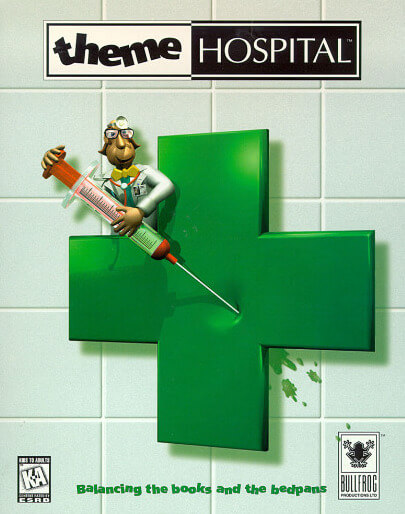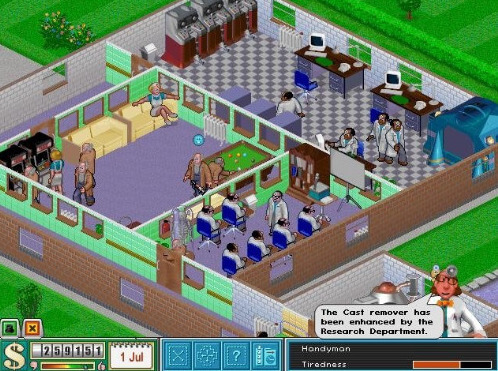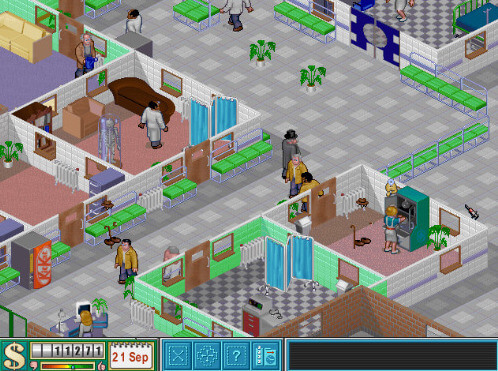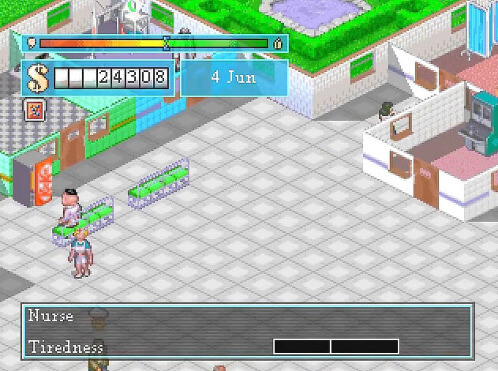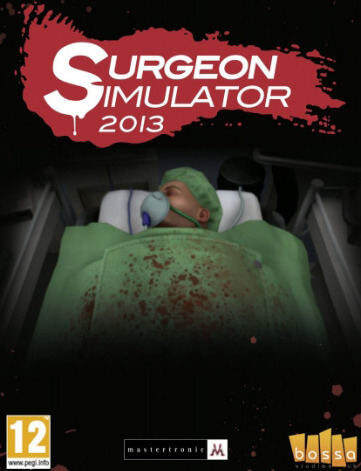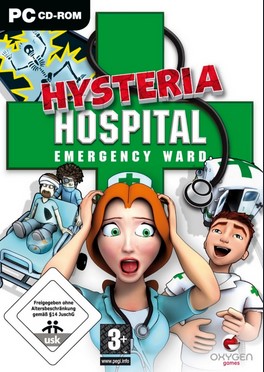Starting with an empty hospital, the player must build rooms and hire doctors, nurses, handymen and receptionists. Each staff member has statistics that affect their performance, and doctors can be trained so their statistics will increase. Rooms include GP's Offices, Psychiatric rooms, Operating Theatres and Pharmacies, and are built by placing down a blueprint, assigning the location of doors and windows, and then placing down required and optional pieces of furniture. The player may also set up items such as benches, fire extinguishers, and plants in the open corridor spaces provided. The player is given time to build the hospital at the start of each level before patients start coming. Patients see a GP in his office who either provides a diagnosis or sends them for further evaluation in a specialised diagnosis room. Once a diagnosis is made, the patient will be sent for treatment. While a few rooms are available at the start of the game, the rest must be researched. Some rooms, such as the Inflator room—where patients with Bloaty Head are treated—contain machines which require regular maintenance by a handyman: if neglected for too long, they will explode, killing all occupants of the room. Doctors must have acquired certain specialist skills to practise in certain rooms, such as the Research room (used to research new rooms and cures, and improve existing ones) and Operating Theatre. There are rooms that only staff use, such as the Staff Room and the Training room, while patients also require certain rooms such as toilet facilities.
Diagnosis and treatment cost patients money, and the player can change hospital policy, including the amount of diagnosis patients require. This can be set to over 100 per cent to force patients to have further unnecessary diagnoses. Other policies include when staff can go on breaks and whether they can leave rooms, and loans can be taken out. From time to time, events such as emergencies (in which patients arrive and must be cured within a time limit or they will die), and epidemics (in which a disease spreads rapidly) occur. During the latter, the player can attempt to cover it up by curing all affected patients before a health inspector turns up. If the player fails, he or she is fined and must face a damaged reputation, a statistic that shows how well the hospital is doing and affects the flow of patients. VIPs may also occasionally ask to tour the hospital; if impressed, the player is granted a cash bonus, a reputation increase, or both. There is an advisor who keeps the player informed about what is going on. Rats may infest the hospital, and the player is able to shoot them with the cursor.
Although the player has no direct control over the patients, they have some influence over whether to evict them from the hospital and in determining what to do with them when given a choice by the staff. The player can pick up any staff member in the building and move them (mainly to reassign them to another room or send them to get rest), or dismiss them if they argue about pay or are no longer required. The player may force patients to take a chance at a cure for their suspected disease before diagnosis is complete (at the risk of killing the patient), and rearrange queues.
The player competes against computer rivals named after famous computers, real and fictional: these include Holly from Red Dwarf and Deep Thought from The Hitchhiker's Guide to the Galaxy. The game is timed with days of the year, and at the end of each year (game time), players are judged on their performances, and may be given trophies, reputation increases, or cash bonuses.
Each level has set goals in the fields of financial attainment, hospital reputation, patients cured, and hospital value. Holding negative funds or allowing sufficient patients to die will bring about losing requirements. When the goals have been met the player has the option to move on to a new, more elaborate hospital with tougher winning conditions and more diseases present, or stick with their current one. If enough rats have been shot, the player is taken to a special level whose goal is to shoot as many as possible.
A patch was released that fixed bugs and added support for Serial Cable, Modem, and IPX/SPX network gaming (with up to four players) in the Windows version, and a difficulty setting. In multiplayer, each player has a colour, which patients will wear to distinguish from those of other players. "Litter Bombs" are featured, allowing players to spread litter around other players' hospitals, while staff members can be persuaded to work for other players, and there are "Mini Missions", with instructions for players to perform. Players are also able to chat with each other during a game.
